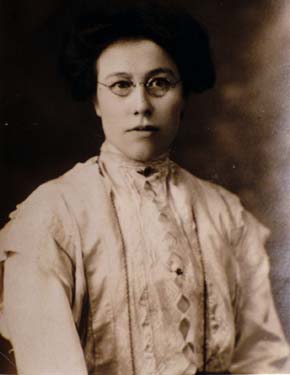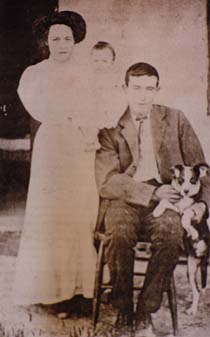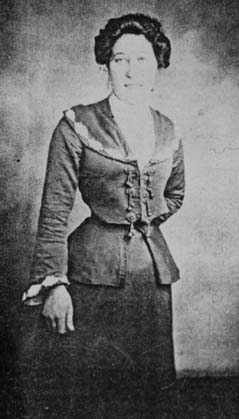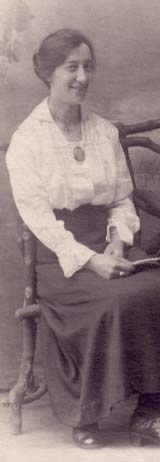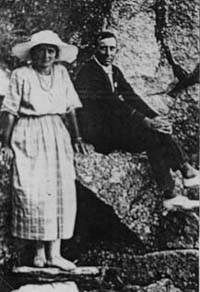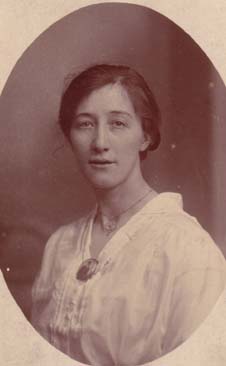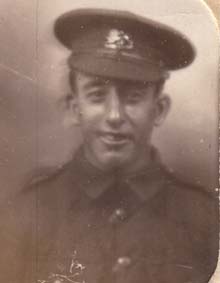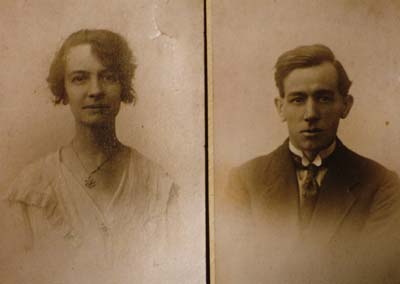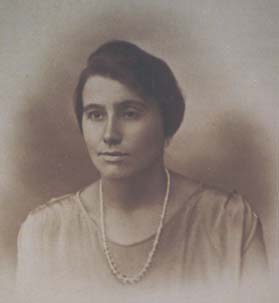|
Rosalind
Davies' Family History |
The children of William & Sarah Ann RIDING
| Maggie | Jack | Alice | Sarah Jane | Gordon | Jenny |
| Lilian | Edison (Ted) | Wilfred | Phyllis | Ethel | . |
Their Children: ************************************************************************************************ Jack was apprenticed to his father as a stonemason at the age of 11. (Although on his enlistment papers, he states that he had never been apprenticed. This probably means that it wasn't a formal situation.) He had a restless spirit and was always looking for new challenges. When he was 16 he walked the length of Britain from John O'Groats to Lands End. In 1906 he worked his passage aboard a ship bound for New Zealand with Edward and Bill Clarke. Finding nothing there to interest him he worked his way back to Sydney and then travelled across three states, eventually buying land in Murray Bridge South Australia. In 1909 he went back to Lancaster to marry Maggie Hacking and they both came back out and settled in Murray Bridge. Vii Jack had his own business as a stonemason in Murray Bridge for a good number of years. He also had several boats which he hired out on the River Murray. He awaited the birth of his son Bill before joining the AIF to serve in the First World War . At that stage Maggie, who was very much a 'town' girl, rented out their home and moved with the children to 12 Chapel Street, Norwood, a suburb of Adelaide.vii Jack enlisted on 13th June 1916 in Adelaide. His medical report states that he was 33 years, 10 months, married with four children , was 5 feet 7 1/2 inches, weighed 137 pounds. His chest measurement expanded was 38 inches. He had a medium complexion with brown eyes and light brown hair. His vision was right 6/6 and left 6/6. He was then appointed as private No. 6093 to 19/10th Battalion then A company, 2nd Depot Battalion, A.I.F. (Australian Imperial Forces). ix He embarked from Adelaide on O.C. Troopship 'Ballarat' on 12th April 1916 and disembarked at Plymouth, England on 30th September 1916. His Battalion then embarked from Folkestone on S.S. 'Princess Victoria/Clementine' on 4th December 1916. On 29th December 1916, the Battalion marched out to join the 1st Australian Infantry Base Depot at Etaples, on the French coast. He then joined the 10th Battalion. By 8th September 1917 he was in a military hospital sick with "Chronic Otitis Media" which is a middle ear infection. He was hospitalised again at Divisional Rest Station at Wippeshock on 10th September for the same complaint and again on 14th, 16th,& 29th September. On 13th October he was transfered to the General Military Hospital at Etaples then onto Cayeux and on 24th November at Havre. On 12th December , he proceeded to rejoin his unit near Havre, France. ix On 29th December 1917 he was detached and joined the Brigade Mining Corp and was granted leave to England on 5th January 1918 for two weeks. He was back in hospital on 22nd June with influenza and was transfered to several different hospital depots until 9th July when he rejoined his unit, the Brigade Mining Corp. ix On 20th September 1918, he was wounded in action (gunshot wound to right forearm) and taken to the General Hospital at Rouen then invalided to England by 'Aberdonian' on 24th September. He was admitted to Dorset County Hospital, Dorchester then to Weymouth Hospital and discharged on 8th November and granted leave until he embarked on H.T. 'Nestor' on 12th December for Australia, arriving on 13th February 1919.He was given the Military Star, the British War Medal and the Victory medal and discharged "Medically unfit not due to misconduct" on 3rd April 1919. Ix On the way home to Australia after the war, Jack's boat was disabled and drifted to an island where they eventually repaired it and sailed on. vi After Jack came back from the war, the family moved back to Murray Bridge. Jack's name is inscribed on the 'Roll of Honour' in the entrance hall of the Murray Bridge Soldiers Memorial Hospital. He resumed his building business and employed six men. The old Picture Theatre in Bridge Street which he built, still remains. He also built Montieth Town Hall in Montieth S.A. It was at this time that he sponsored several members of the family to emigrate. Vii In 1927 , because of the Great Depression, the family moved to Glenelg, a seaside suburb of Adelaide,looking for work. In 1935/6 they moved to Victoria for a period, where Jack was employed to use his specific skills in stonemasonry. They lived in several places before moving back to Prospect S.A. in 1939. vii Jack & Maggie agreed to bring up their granddaughter Marney after
her mother's divorce from Ted Webster as Helen's new husband Frank Norton
was not willing to accept her in the marriage. Vii Maggie's story: |
Bill Clark came out to Australia in 1906 with his brother, Edward and
friend Jack Riding (his future brother-in-law)Vii |
|
||||||||||
Gordon was apprenticed to John Hatch & Sons, Lancaster for seven
years as a stone cutter. Ix He left England on 1 April 1911 on the SS
Ionic and emigrated to Australia . He came out to help his brother,
Jack, by cutting stone for a school in Murray Bridge and intended to
return to England after the job was completed. However, with his other
brother out of work in England, he decided to stay in Australia and
bring out both his fiance and his brother. xvii Jeanette Smith left
England on 11 December 1911 on the TSS Waimana .viii On the day after
she arrived, they married in Murray Bridge . The train arrived from
Adelaide at 10am and the service started at 1pm. A stranger picked some
flowers from her garden and presented them to the bride for her wedding.
Xvii They lived with Jack and Maggie Riding for a few months but the
work ran out and they moved to Adelaide in October 1912 . In 1915 ,
they were living at Barnes Road, Payneham but finally settling in Glenelg,
a seaside suburb of Adelaide. Vii He joined the "D", 27th Infantry Division A.I.F. on 13th
February 1915. His active service forms state that he embarked overseas
per H.M.A.T. 'Geelong', on 31st May 1915 and arrived in Alexandria,
Egypt, on 4th September 1915 to join the Mediterranean Expeditionary
Force (Gallipoli) . He again disembarked in Alexandria on 10th January
1916 and was transfered to the 2nd Pioneer Battalion in Ismailia, Egypt.
His unit then proceeded to join the British Expeditionary Force on 19th
March 1916 and disembarked in Marseilles (France) on 26th March 1916.
On 6th September 1916, he was awarded the Military Medal by the Army
Corps Command in the field, "for services rendered during recent
fighting at Pozieres, France." Another form states that he received
his medal for " Gallantry and Self Sacrifice displayed during the
recent fighting at Pozieres," France. Family sources say that he
received commendation for bringing in a wounded lieutenant under heavy
machine gun fire. Whilst on leave on 2nd November 1916, he was admitted to hospital in Lancaster then transfered to the 1st Auxiliary Military Hospital at Harefield Park, Middlesex, N.Y.D. ( not yet diagnosed). On 22nd December 1916 whilst at Harefield Park Hospital his diagnosis was "Pleuro pneumonia from Ypres", his temperature rose every evening but he showed no signs of TB in his sputum. The Board's finding on 9th January 1917 was that he was permanently unfit for general service and unfit for Home Service for more than 4 months. Signed by Col. H.C. Maudsley. Major James A. Smeal, Australian Army Medical Corps, wrote on 10th January 1917, "Tubercule Bacilli found in sputum since the above report written. " To the question " To what extent is his capacity for earning a full livelihood in the general labour market lessened at present?" the answer was " 1/4, one quarter". On 22nd February 1917, Gordon embarked at the port of Avonmouth and
returned to Australia on a Lower Berth on H.S. 'Karoola' with "Pleurisy
and Pneumonia". He disembarked in Melbourne on 10th April 1917
and was transfered to the hospital at Keswick, Adelaide. On 12th April
1917 his records states " Complaining of cough and expectoration.
Right side of chest moves less than left. PN dull over extensive area,
front and back. Breath sounds are weak. Heart sounds are weak also.
Sputum shows no TB but abundant mixed micro -organisms. Discharged as
medically unfit, incapacity 3/4. " His Medical Report of 29th December 1916 states that the date and place
of the origin of his disability was 28th September 1916 at Ypres, France.
"Invalided with Pleuro pneumonia . No previous history of that
trouble. Pleura tapped 3 weeks later." Cause, " climate exposure". After returning home, the doors of their house were widened to accommodate his wheelchair . The Red Cross gave them a car and Aunt Jeanette drove them both to Sydney once and regularly to Port Augusta to get fish from the boats. Lena Huntington remembers them regularly driving to Murray Bridge at Easter. Once Aunt Jeanette showed her a small length of blue ribbon Uncle Gordon had tied around her finger and said, "Now we are engaged." There was a photograph of him in "The Advertiser" showing him in a wheel chair shaking the hand of the Duke of Gloucester. (Photo available) His brother Jack would make him very annoyed by alluding to his large nose as follows... "I reckon as how grandfather Robinson crossed the River Jordan." {meaning it looked Jewish} iii |
|||||||||||||
5. Janet ( Jenny) RIDING- my grandmother ; click here for a separate chapter
The steamer left Tilbury Docks London on 18th
October 1923. They had been sponsored as migrants by Lilian's brother
Jack and their ticket shows that they were third class or steerage passengers.
Their cabins held eight births and the males and females were separated.
Tom and Wilfred's ticket cost £49.10.0 whilst Lilian and Margery's
ticket cost £33 (half price for females) The ticket has some interesting
specifications. Their luggage could not exceed fifteen cubic feet per
person but anything over that could not exceed a value of £10.
Their weekly provisions were clearly stated. Per month, per adult they
were: |
Edison was known as Ted. As a young man he was a voluntary cadet in the
Territorial unit of the 5th Batt.Kings Own Lancaster Regiment. xix He
came out to Australia in December 1911 on 'TSS Waimana', the same ship
as his future sister-in-law Jeanette Smith. Whilst in Australia, he
worked on the railways at Tailem Bend near Murray Bridge S.A.iii He
regularly sent money home for his mother and was in constant communication
with the family. Xix |
|||||||||||||
Wilfred (known as Bill), who was 20 when he joined up, served firstly
in the 5th Battalion Kings Own Regiment in the British Expeditionary
Forces but spent most of the war years with the Seaforth Highland Regiment
as a private #3298. xxviii He volunteered for several courses. He was
a very good shot and at one time he had a sniper's shot gun and represented
his Company in a shooting tournament. He also joined the Cycling Corps
attached to the Seaforths. xxii In 1914, just before his mother died,
he sent her a religious card from Holland, which she loving kept in
her Prayer Book.xxiv (photo available) |
9. Phyllis Riding born 1895 but died when a small child
|
|
Footnotes: i. Birth Certificate (copies available ) |
Main Lancashire page | My Family History Menu | Home
by Ros Davies
